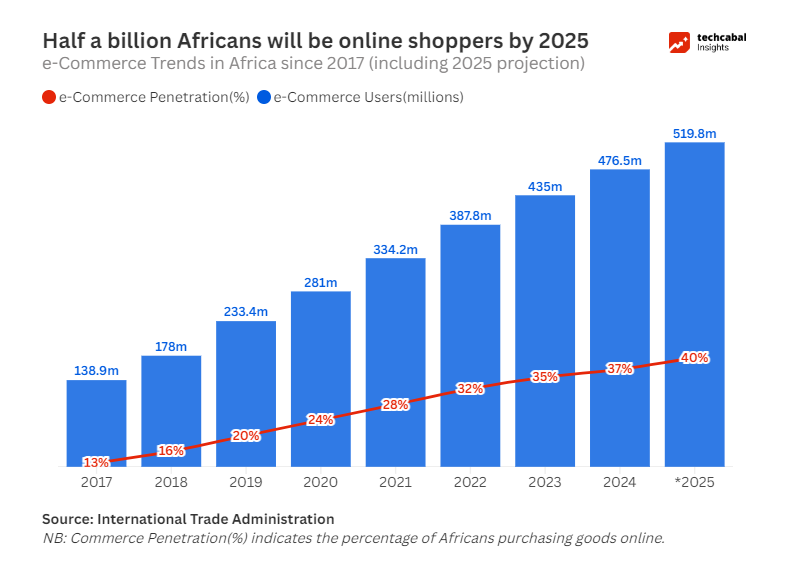In Summary
- Over the past twenty years, household spending in Sub-Saharan Africa has grown 150% faster than the population.
- Total household consumption in Africa will reach $2.1 trillion by the end of 2025 and over 2.5 trillion by 2030.
- Large multinationals are investing in their production capacity to meet the growing demands of the African market.
- According to reports, 95% of the consumer class that decides Africa’s consumer market spending habits resides in just 20 out of the 54 countries.
Deep Dive
Like almost every other sector, Africa’s consumer market is growing. By the end of last year, it was reported that total household spending in Sub-Saharan Africa had grown 150% faster than the population rate. The growth is driven by urbanization, a rising middle class, and increased consumer demand—with Africans’ total consumption projected to reach $4 trillion by the end of 2025.
According to Landry Signé, a senior fellow in the Global Economy and Development Program and the Africa Growth Initiative at the Brookings Institution, the total household consumption in Africa will reach $2.1 trillion by the end of 2025 and 2.5 trillion by 2030. The report is reflected in the investment made by large multinationals such as Kraft Foods, Johnson & Johnson, and Volkswagen to expand their production capacities and ramp up their presence on the continent to meet this growing demand.
However, it is important to note that defining and measuring Africa’s middle class presents significant challenges due to the continent’s economic diversity and data limitations. Traditional metrics, such as average annual income, often fall short of capturing the true scope of this demographic. For instance, the Pew Research Center classifies middle-income households as those earning between two-thirds and twice the national median income.
For this list, we have calculated the total Consumer Market Spending Habits of African countries by aggregating the total amount spent by individuals and households on goods and services within the last fiscal year by relying on data from retail sales, surveys, and government statistics, with key metrics including Personal Consumption Expenditure (PCE) which reflects the overall value of consumer spending within an economy and is a significant component of GDP.
Considering the above as the metrics for our ranking, below is an overview of the top 10 African countries with the highest consumer market spending habits in 2025.

Check Out the top 10 Countries with the Highest Consumer Market Spending Habits in Africa 2025
10. Côte d’Ivoire
Côte d’Ivoire’s economic resurgence has led to increased consumer spending, especially in Abidjan, the economic capital. Key areas of expenditure include food and beverages, clothing, and entertainment. The country’s position as a regional trade hub enhances its consumer market dynamics.
9. Tanzania
Tanzania’s steady economic growth has fostered an expanding consumer market. Dar es Salaam, the largest city, is a central hub for consumer activities, with spending concentrated in sectors such as telecommunications, transportation, and retail. The youthful population is a driving force behind the demand for modern goods and services.
8. Angola
Angola’s oil wealth has contributed to a significant consumer market, particularly in Luanda, the capital city. Consumer spending is prominent in areas like luxury goods, real estate, and imported foods. However, the market is also characterized by disparities, with a growing need for affordable consumer goods.
7. Ethiopia
Ethiopia’s rapid economic development has translated into a growing consumer market. Addis Ababa, the capital, is at the heart of consumer spending, with notable expenditures in transportation, housing, and personal care products. The country’s investments in industrialization have also led to increased disposable incomes.
6. Ghana
Ghana’s consistent economic growth has led to increased consumer spending, especially in urban areas such as Accra and Kumasi. Key spending sectors include housing, education, and healthcare. The rise of shopping malls and retail outlets reflects the evolving consumer landscape.
5. Morocco
Morocco’s stable economy and strategic trade relationships have bolstered its consumer market. Urban centers like Casablanca and Marrakech are focal points for consumer spending, particularly in textiles, handicrafts, and tourism-related services. The country’s emphasis on infrastructure development has further stimulated consumer activities.
4. Kenya
Kenya’s consumer market is on an upward trajectory, driven by a burgeoning middle class and technological advancements. Nairobi, the capital city, is central to consumer spending, especially in sectors such as mobile technology, financial services, and fast-moving consumer goods. The widespread adoption of mobile money platforms has revolutionized purchasing behaviors.
3. Egypt
Egypt’s strategic location and growing population make it a key player in Africa’s consumer market. Cairo, the capital, is a major hub for consumer activities, with significant spending in areas like food and beverages, electronics, and tourism. The government’s economic reforms have also enhanced consumer confidence and spending power.
2. South Africa
South Africa’s diversified economy supports a robust consumer market. Major urban areas such as Johannesburg and Cape Town contribute significantly to consumer spending, particularly in sectors like retail, automotive, and real estate. The country’s well-established financial infrastructure and retail chains cater to a broad spectrum of consumer needs.
1. Nigeria
As Africa’s most populous nation, Nigeria boasts a substantial consumer market. The country’s consumer spending is propelled by its large youth population and expanding urban centers like Lagos and Abuja. Key spending areas include telecommunications, fashion, and entertainment. The rise of e-commerce platforms has further facilitated consumer access to a variety of goods and services.
Conclusion
This ranking is based on various factors, including economic growth, population size, urbanization, and sectoral contributions to consumer spending. However, it’s important to note that these factors can change over time due to economic developments and policy changes.
While these countries lead in consumer spending, the overall landscape is influenced by various factors, including economic policies, population growth, and external economic conditions. The projected growth in Africa’s consumer market underscores the continent’s potential as a significant player in the global economy.
https://www.africanexponent.com/top-10-countries-with-the-highest-consumer-market-spending-habits-in-africa-2025/


